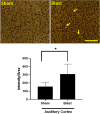Longitudinal Biochemical and Behavioral Alterations in a Gyrencephalic Model of Blast-Related Mild Traumatic Brain Injury
- PMID: 38515547
- PMCID: PMC10956534
- DOI: 10.1089/neur.2024.0002
Longitudinal Biochemical and Behavioral Alterations in a Gyrencephalic Model of Blast-Related Mild Traumatic Brain Injury
Abstract
Blast-related traumatic brain injury (bTBI) is a major cause of neurological disorders in the U.S. military that can adversely impact some civilian populations as well and can lead to lifelong deficits and diminished quality of life. Among these types of injuries, the long-term sequelae are poorly understood because of variability in intensity and number of the blast exposure, as well as the range of subsequent symptoms that can overlap with those resulting from other traumatic events (e.g., post-traumatic stress disorder). Despite the valuable insights that rodent models have provided, there is a growing interest in using injury models using species with neuroanatomical features that more closely resemble the human brain. With this purpose, we established a gyrencephalic model of blast injury in ferrets, which underwent blast exposure applying conditions that closely mimic those associated with primary blast injuries to warfighters. In this study, we evaluated brain biochemical, microstructural, and behavioral profiles after blast exposure using in vivo longitudinal magnetic resonance imaging, histology, and behavioral assessments. In ferrets subjected to blast, the following alterations were found: 1) heightened impulsivity in decision making associated with pre-frontal cortex/amygdalar axis dysfunction; 2) transiently increased glutamate levels that are consistent with earlier findings during subacute stages post-TBI and may be involved in concomitant behavioral deficits; 3) abnormally high brain N-acetylaspartate levels that potentially reveal disrupted lipid synthesis and/or energy metabolism; and 4) dysfunction of pre-frontal cortex/auditory cortex signaling cascades that may reflect similar perturbations underlying secondary psychiatric disorders observed in warfighters after blast exposure.
Keywords: biochemical and behavioral alterations; ferret; in vivo magnetic resonance spectroscopy; mild TBI; primary blast.
© Shiyu Tang et al., 2024; Published by Mary Ann Liebert, Inc.
Conflict of interest statement
No competing financial interests exist. Material has been reviewed by the Walter Reed Army Institute of Research. There is no objection to its presentation and/or publication. The opinions or assertions contained herein are the private views of the author, and are not to be construed as official, or as reflecting true views of the Department of the Army or the Department of Defense. Research was conducted under an IACUC-approved animal use protocol in an AAALAC International - accredited facility with a Public Health Services Animal Welfare Assurance and in compliance with the Animal Welfare Act and other federal statutes and regulations relating to laboratory animals.
Figures






Similar articles
-
[Mild traumatic brain injury and postconcussive syndrome: a re-emergent questioning].Encephale. 2012 Sep;38(4):329-35. doi: 10.1016/j.encep.2011.07.003. Epub 2011 Aug 31. Encephale. 2012. PMID: 22980474 Review. French.
-
Disrupted modular organization of resting-state cortical functional connectivity in U.S. military personnel following concussive 'mild' blast-related traumatic brain injury.Neuroimage. 2014 Jan 1;84:76-96. doi: 10.1016/j.neuroimage.2013.08.017. Epub 2013 Aug 20. Neuroimage. 2014. PMID: 23968735 Free PMC article.
-
The role of biomarkers and MEG-based imaging markers in the diagnosis of post-traumatic stress disorder and blast-induced mild traumatic brain injury.Psychoneuroendocrinology. 2016 Jan;63:398-409. doi: 10.1016/j.psyneuen.2015.02.008. Epub 2015 Feb 23. Psychoneuroendocrinology. 2016. PMID: 25769625
-
Upregulation of multiple toll-like receptors in ferret brain after blast exposure: Potential targets for treatment.Neurosci Lett. 2023 Jul 27;810:137364. doi: 10.1016/j.neulet.2023.137364. Epub 2023 Jun 28. Neurosci Lett. 2023. PMID: 37391063
-
Behavioral Deficits in Animal Models of Blast Traumatic Brain Injury.Front Neurol. 2020 Sep 4;11:990. doi: 10.3389/fneur.2020.00990. eCollection 2020. Front Neurol. 2020. PMID: 33013653 Free PMC article. Review.
References
LinkOut - more resources
Full Text Sources
Research Materials
